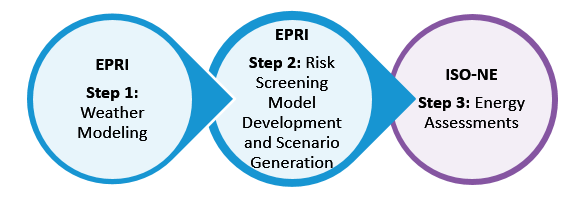ISO-NE’s study of energy shortfall risks produces innovative tool for assessing energy adequacy

With the completion of the Operational Impact of Extreme Weather Events study, a first-of-its-kind analysis examining how the region’s power system would fare under stressful weather and operational conditions, ISO New England has delivered a detailed snapshot of energy shortfall risks in 2027 and 2032. Energy shortfalls happen when the region’s electricity supply falls below consumer demand.
Importantly, this initiative also produced an innovative new framework that will support and inform the region’s reliable transition to clean energy. The ISO’s Probabilistic Energy Adequacy Tool (PEAT) will help identify circumstances that could lead to an energy shortfall, giving the region’s stakeholders advance warning and the opportunity to take steps to avert it. The tool could have applications for other regions grappling with similar energy adequacy concerns.
Stephen George, director, Operational Performance, Training, and Integration, and Jinye Zhao, technical manager, Advanced Technology Solutions, have shared a final report highlighting key learnings that show the winter energy shortfall risk appears manageable in the near-term over a 21-day period, and that the region’s energy shortfall risk in general is dynamic, and will evolve along with supply and demand profiles.
“As climate projections are refined and the region’s resource mix evolves, we plan to use PEAT to evaluate the impact of extreme weather scenarios again and again,” George said. “This ensures that our assessments of risk evolve along with our understanding of how the future grid will operate. That will be important not just in New England, but across the nation as more of our energy comes from renewable, distributed, and limited energy resources.”
Study process
Operational Impacts of Extreme Weather Events, a probabilistic energy-adequacy study undertaken jointly by the ISO and the Electric Power Research Institute (EPRI), recognized the increasingly important role weather plays in power system operations. The study examined how factors like temperature, cloud cover, and wind speed might impact electric power generation in the future, when the regional grid is more heavily powered by renewable resources sensitive to these conditions. Climate change was taken into consideration when modeling future extreme weather scenarios. The study also took into account evolving grid demand patterns that will continue to change as more behind-the-meter photovoltaic (BTM PV) resources come online and electrification of the heating and transportation sectors increases.
The study was undertaken in three major steps, with EPRI providing weather modeling and risk screening model development, and ISO completing the energy assessments, using its 21-day energy assessment tool.

Every aspect of the study, from methodology to weather event selection, was discussed at meetings of the NEPOOL Reliability Committee. George and Zhao presented detailed updates on and results from the project at 15 meetings over 19 months, seeking input every step of the way, and building stakeholder confidence in the tool’s validity.
Key takeaways
The study examined two target years: 2027 and 2032. Preliminary results of Step 3 energy assessments were presented for the 2027 winter events in May, for the 2027 summer events in July, for the 2032 winter events in August, and for the 2032 summer events in September.
In addition, the ISO performed a number of stakeholder sensitivity analysis requests, focused primarily on the sensitivity of energy shortfalls related to the impacts of additional renewables and hypothetical generator retirements under the worst-case winter scenario. These analyses were performed using data from the ISO’s 2023 Capacity, Energy, Loads, and Transmission (CELT) Report, the latest information available. Results were shared in November.
At a high level, results from the target years studied as well as the additional stakeholder-requested sensitivity analyses revealed several key findings:
- The region’s energy shortfall risk is dynamic, and will be a function of the evolution of the supply and demand profiles. Risk could increase if expected renewable resources don’t materialize, needed transmission isn’t built, or fuel supply chains are disrupted.
- In the near-term, the winter energy shortfall risk appears manageable over the range of 21-day periods studied. “Manageable” means the ISO would use existing tools, such as calling for assistance from neighboring power systems or asking the public to conserve electricity use in order to reduce the risk or mitigate the impact of an energy shortfall.
- Analysis of 2032 worst-case winter scenarios indicates an increasing energy shortfall risk profile between 2027 and 2032 due to generation retirement and increasing electrification load forecasted in the 2023 CELT report.
- Timely additions of behind-the-meter and utility-scale PV, offshore wind, and incremental imports from the New England Clean Energy Connect (NECEC) transmission project are needed to mitigate energy shortfall risks that result from peak winter load growth and retirements.
- There is similar energy adequacy risk with and without the Everett Marine Terminal in service.
- Assessments of summer events found no energy shortfall risk.
It’s important to understand that the ISO’s initial assessment—that energy shortfall risk is manageable—is not a guarantee of energy adequacy in the next decade. If key assumptions don’t hold, an increasingly risky energy shortfall profile could emerge. The PEAT framework provides the ISO with sophisticated tools to help monitor energy shortfall risk as the system evolves.
New tools will help support the clean-energy transition
With the operational study complete, ISO expects that PEAT will be incorporated into the ISO’s energy assessments, helping to identify energy adequacy risk over different timeframes, including seasonal assessments. In addition, the ISO will use results of the initial study to work with stakeholders on a Regional Energy Shortfall Threshold (REST), establishing an acceptable level of energy shortfall risk common to the six states.
Having this measure in place allows the ISO to take action, evaluating whether specific solutions are needed to help the region maintain the agreed-upon margin. These might include adjustments to market designs, investments in infrastructure, or dynamic retail pricing and additional responsiveness by end-use consumers. Some of these solutions fall under the purview of the New England states, who will be key participants in the regional discussions. Determinations on the scope, timing and feasibility of any such solutions would happen in 2024 and 2025.
While PEAT and REST represent important new tools to help plan and operate the evolving power system, the ISO also maintains a focus on the health of the four pillars—the elements needed to achieve tomorrow’s cleaner grid.
“With more insight into how the future system will operate, and a deep understanding of how prepared the region is to support it, we have important guideposts in place that will help define the region’s path forward,” said Anne George, vice president, Chief External Affairs and Communications Officer. “We look forward to working with the region’s energy stakeholders to achieve a reliable and cost-effective clean-energy transition.”
- Categories
- Industry News & Developments
- Tags
- energy adequacy, system operations, weather




